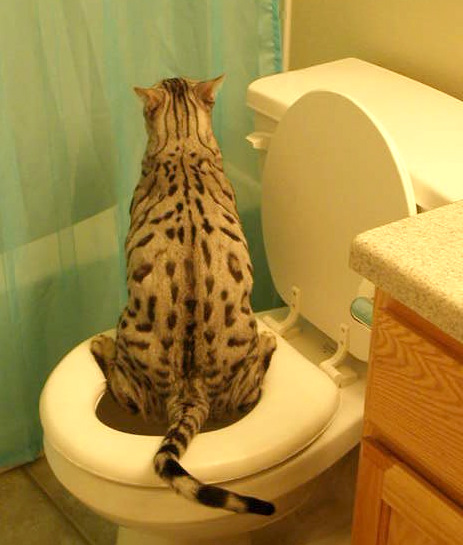What're your thoughts with regards to Can You Flush Cat Poop Down The Toilet??

Introduction
As feline owners, it's necessary to be mindful of exactly how we get rid of our feline pals' waste. While it may seem convenient to flush cat poop down the commode, this technique can have destructive effects for both the setting and human health and wellness.
Alternatives to Flushing
Luckily, there are much safer and more responsible means to take care of pet cat poop. Think about the complying with alternatives:
1. Scoop and Dispose in Trash
The most usual approach of throwing away feline poop is to scoop it into a biodegradable bag and throw it in the garbage. Be sure to use a dedicated clutter inside story and deal with the waste promptly.
2. Usage Biodegradable Litter
Select naturally degradable feline litter made from products such as corn or wheat. These litters are environmentally friendly and can be securely gotten rid of in the trash.
3. Hide in the Yard
If you have a yard, consider hiding cat waste in a marked area away from veggie gardens and water sources. Make sure to dig deep enough to stop contamination of groundwater.
4. Set Up a Pet Waste Disposal System
Invest in a family pet waste disposal system especially developed for cat waste. These systems utilize enzymes to break down the waste, reducing smell and environmental effect.
Health Risks
Along with environmental worries, flushing pet cat waste can also present health threats to people. Pet cat feces may have Toxoplasma gondii, a parasite that can create toxoplasmosis-- a potentially serious illness, especially for pregnant ladies and people with weakened body immune systems.
Environmental Impact
Purging pet cat poop introduces unsafe pathogens and bloodsuckers right into the supply of water, posturing a significant danger to marine communities. These impurities can negatively affect aquatic life and compromise water high quality.
Final thought
Liable animal possession expands beyond offering food and sanctuary-- it also includes appropriate waste monitoring. By refraining from flushing feline poop down the commode and opting for alternative disposal techniques, we can decrease our ecological footprint and safeguard human health and wellness.
Why Can’t I Flush Cat Poop?
It Spreads a Parasite
Cats are frequently infected with a parasite called toxoplasma gondii. The parasite causes an infection called toxoplasmosis. It is usually harmless to cats. The parasite only uses cat poop as a host for its eggs. Otherwise, the cat’s immune system usually keeps the infection at low enough levels to maintain its own health. But it does not stop the develop of eggs. These eggs are tiny and surprisingly tough. They may survive for a year before they begin to grow. But that’s the problem.
Our wastewater system is not designed to deal with toxoplasmosis eggs. Instead, most eggs will flush from your toilet into sewers and wastewater management plants. After the sewage is treated for many other harmful things in it, it is typically released into local rivers, lakes, or oceans. Here, the toxoplasmosis eggs can find new hosts, including starfish, crabs, otters, and many other wildlife. For many, this is a significant risk to their health. Toxoplasmosis can also end up infecting water sources that are important for agriculture, which means our deer, pigs, and sheep can get infected too.
Is There Risk to Humans?
There can be a risk to human life from flushing cat poop down the toilet. If you do so, the parasites from your cat’s poop can end up in shellfish, game animals, or livestock. If this meat is then served raw or undercooked, the people who eat it can get sick.
In fact, according to the CDC, 40 million people in the United States are infected with toxoplasma gondii. They get it from exposure to infected seafood, or from some kind of cat poop contamination, like drinking from a stream that is contaminated or touching anything that has come into contact with cat poop. That includes just cleaning a cat litter box.
Most people who get infected with these parasites will not develop any symptoms. However, for pregnant women or for those with compromised immune systems, the parasite can cause severe health problems.
How to Handle Cat Poop
The best way to handle cat poop is actually to clean the box more often. The eggs that the parasite sheds will not become active until one to five days after the cat poops. That means that if you clean daily, you’re much less likely to come into direct contact with infectious eggs.
That said, always dispose of cat poop in the garbage and not down the toilet. Wash your hands before and after you clean the litter box, and bring the bag of poop right outside to your garbage bins.
https://trenchlesssolutionsusa.com/why-cant-i-flush-cat-poop/

Hopefully you enjoyed reading our topic about How to Dispose of Cat Poop and Litter Without Plastic Bags. Many thanks for taking the time to read our piece. Sharing is nice. Helping people is fun. Thank-you for your time spent reading it.
Call Today
Comments on “Dangers of Flushing Cat Poop in Your Toilet - Precautionary Steps”